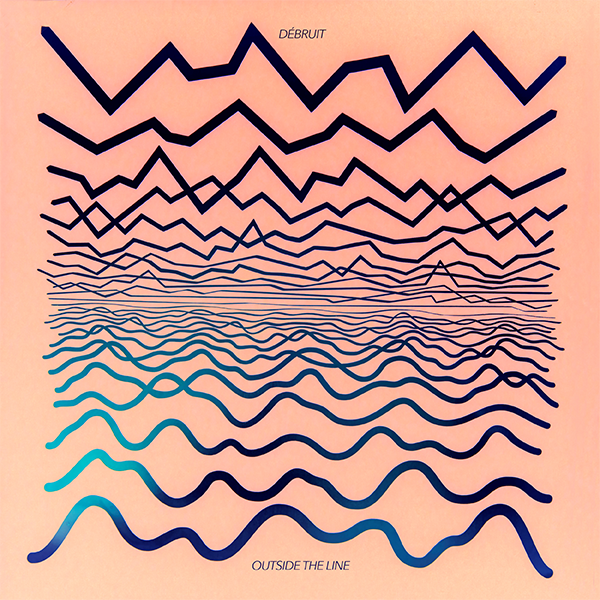A deep breath, and then it begins.

rhythmical as a drum
Of an unknown present
I haven’t swum
It might’ve been the past
you know how time bends.”
– débruit – “Drift”
Once upon a time, in the years of our lord 1977 – 1980, in the wild, wild boroughs of New York, young people with crazy hair-dos gathered in derelict warehouses, crusty nightclubs, delis and pizza shops to thrash about to the sounds of punk rock, electro, early hip-hop, disco and funk.
Such cross-pollination would become increasingly rare as those genres solidified, creating their own social strata and hierarchies. That’s to be expected, right? In this world, post-punk would rarely mingle with hip-hop, despite the fact that they were came from within blocks of each other, created by many of the same musicians — let alone with beats and chants from the West Coast of Africa.
That is not to suggest, however, that Outside The Line is some clever anachronism, some faux-’80s NYC hip-hop mixtape. Instead, débruit envisions soundscapes for places that never were, something mythically early ’80s NYC, with an African refugee being deposited into a city of lasers and rust, synclavier DJs hijacking power from streetlamps to hold kalimba-infused streetcorner raves.
On album opener “Drift”, Outside The Line begins with a snippet of spoken samples, set over a bedrock of coruscating staticky noise lapping up around the listener’s ankles like seafoam. It’s the only outright lyrical moment of the record, so it’s natural to read into it as a sort of manifesto or mission statement of the record, calling to mind some run-down Ridley Scott concrete expanse with a vibrant dock life. It quickly breaks into the Atari kalimba sculptures of “Separated Together”, which owes as much to Floating Points and Arca as it does the Serengeti and whisper singing. It’s when things really start to whirr and take on shape, and we begin to see what débruit is doing.
It’s not entirely a revelation to draw a line from African rhythms to early hip-hop, but what does this have to do with coldwave? For those that don’t know, coldwave, also called minimal wave. was a style of lo-fi post-punk, popular in European countries like France, in the late ’70s and early ’80s. How does this factor in this imaginary continent débruit is constructing?
Coldwave can be typified by the raw, rough, and immediate sound of recording directly to tape deck, which became cheap enough in the late ’70s for everybody to have them. This decentralized the recording industry, broadening the scope of what sounds acceptable as music, favoring the real, the personal and the adventurous over sterling, radio ready production quality.
Outside the Line was conceived to be a kind of “African coldwave” release, imaging an alternative 1977 – 1980 where NYC natives mingled Ghanian beats with European electro/trance/disco/house.
The music and production on Outside the Line benefits from the immediacy of coldwave’s lo-fi approach, like dropping in on someone’s bedroom jam sessions, if that jam happened to be taking place in a treehouse on Jupiter. It brings the focus back to musicality and instinct, rather than clinical perfection, which is difficult to achieve with electronic music, particularly when working digitally. It’s all too easy (and tempting), to slice and dice and polish indefinitely, ad infinitum. Outside the Line is not a piece of hardware hacking, the sound of letting machines fly, like some early ’90s trance record; there’s a bit of that, but more specifically, débruit’s alternate reality African poly-sculptures owe more to Chicago footwork and the L.A. beat scene. It seems that débruit took the time to source his beats, bumps, and clicks from analog kits, but then dropped them into some rack for further sequencing and processing. The difference? The beats fly and swarm and thump and pound and scratch with a million times more precision, more intricacy, than with some preset hacking generIDM.
débruit is not attempting to convey the sound of the Savannah on Outside the Line. It’s not authentic, nor is it striving to be. Yet we are all coming together, meeting in the middle, in abstract continents of thought that lie somewhere between here and there.
Bringing all of these disparate sounds and styles acts as a kind of selective musical breeding, with débruit honing the strengths of each genre, while managing to ditch most of the shortcomings. Most notably, Outside the Line funks up the sometimes sterile world of 4/4 dancefloor creations, layering percussive polyrhythms over a solid technoid foundation, while synthetic African melodies sound like Gameboy thumb piano jams and Vangelis scoring Asteroids. It’s a crazy colorful world, that’s fun to bounce to.

ω






